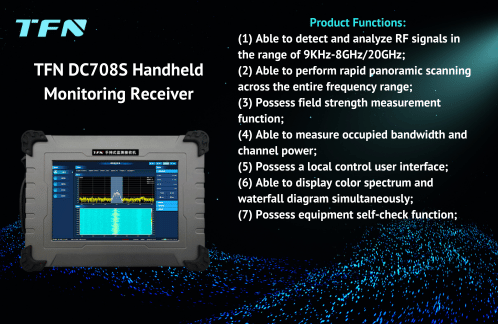How to use portable monitoring receivers for real-time public safety and intelligence monitoring?
In today's society, public safety and intelligence monitoring are of immeasurable value for maintaining social stability, preventing crime, and responding quickly to emergencies. A portable monitoring receiver is a lightweight, portable device that can detect and analyze radio signals in real time, covers a wide range of frequency bands, has spectrum display, field strength measurement and other functions, and is suitable for rapid on-site monitoring. This article will discuss in detail how to use portable monitoring receivers for real-time public safety and intelligence monitoring. This task involves multiple links such as equipment selection, deployment, operation, and data processing and analysis.
The following are specific methods and steps:
1. Equipment selection and preparation
1.1 Select a suitable portable monitoring receiver: Considering the particularity of public safety and intelligence monitoring, it is necessary to select a portable monitoring receiver with wide frequency band coverage, powerful signal processing capabilities, high sensitivity and high stability. It is preferred to have equipment with real-time spectrum scanning, signal demodulation, data analysis and other functions to accurately capture and analyze signals in complex environments.
1.2 Prepare necessary accessories and tools: including antennas, power supplies, cables, storage devices, etc., to ensure that the equipment can operate normally and meet the needs of long-term monitoring.
2. On-site deployment and settings
2.1 Select a suitable monitoring location: According to the characteristics and scope of the monitoring target, select a monitoring location that can cover the key area. Pay attention to avoid obstructions and interference sources to ensure the quality of signal reception.
2.2 Install and fix the equipment: Install and fix the portable monitoring receiver to ensure that the equipment is stable and not easily moved or damaged. Connect accessories such as antennas and power supplies to ensure that the equipment can receive and process signals normally.
2.3 Set equipment parameters: Set the receiver's frequency band, demodulation mode, trigger conditions and other parameters according to monitoring requirements. For example, you can set a specific frequency band range to filter irrelevant signals, or set trigger conditions to automatically capture abnormal signals.
3. Real-time monitoring and data processing
3.1 Start the device to start monitoring: Turn on the portable monitoring receiver and start the real-time monitoring function. The device will start to receive and process radio signals and convert them into understandable information forms.
3.2 Analyze signals and identify abnormalities: Monitoring personnel need to pay close attention to signal changes and use the analysis function of the equipment to identify and classify signals. Pay attention to identifying abnormal signals that may be related to public security or intelligence monitoring, such as illegal radio station signals, eavesdropping device signals, etc.
3.3 Recording and reporting: Regularly record monitoring data, including key information such as signal strength, frequency, and demodulation content. Summarize and analyze the data as needed, and form a report for subsequent reference or submission to relevant departments.
4. Collaboration and emergency response
4.1 Collaboration with other monitoring equipment: Portable monitoring receivers can work with other monitoring equipment (such as fixed monitoring stations, drones, etc.) to form a more complete and effective monitoring network. Improve the accuracy and timeliness of monitoring through data sharing and linkage response.
4.2 Emergency response: Once an abnormal signal or emergency is found, the monitoring personnel should immediately activate the emergency response mechanism. Take corresponding measures according to the plan, such as reporting to relevant departments, mobilizing resources for disposal, etc.
5. Continuous optimization and improvement
5.1 Technology upgrade and equipment update: With the continuous development of technology, the performance and functions of portable monitoring receivers are also constantly improving. Monitoring agencies should regularly evaluate the performance of existing equipment and carry out technology upgrades and equipment updates as needed.
5.2 Training and drills: Strengthen the training and drills of monitoring personnel to improve their professional skills and emergency response capabilities. Through simulated actual combat scenarios, drills are carried out to ensure that monitoring personnel can master the equipment operation methods and emergency response processes.
Therefore, the use of portable monitoring receivers for real-time public safety and intelligence monitoring requires comprehensive consideration of multiple aspects. Through scientific planning, careful deployment and effective execution, accurate and timely monitoring of radio signals can be achieved, providing strong support for public safety and intelligence work.
TFN's DC708S handheld monitoring receiver can play an important role in real-time public safety and intelligence monitoring, mainly due to its advanced functional features:
Wideband detection and analysis capabilities: It can detect and analyze RF signals in the range of 9KHz to 8GHz, which ensures that the device can capture a variety of radio signals from low-frequency communications to high-frequency radar.
Fast panoramic scanning: With the ability to perform fast panoramic scanning across the entire frequency range, potential threat signals or abnormal activities can be quickly located and identified.
Field strength measurement and bandwidth power analysis: The field strength measurement function can accurately evaluate the strength distribution of the signal, which helps to determine the location of the signal source or evaluate the coverage range of the signal; the measurement of occupied bandwidth and channel power functions helps to analyze the spectral characteristics of the signal.
Real-time spectrum display and waterfall chart analysis: The spectrum chart can show the distribution of signals in the current frequency range, and the waterfall chart can record the trend of signal changes over time. This real-time visual analysis tool helps monitoring personnel quickly identify signal characteristics and track signal sources.

If you are interested in TFN DC708S handheld monitoring receiver, please contact TFN sales team:
Email: info@tfngj.com
WhatsApp: +86-18765219251
Facebook: https://www.facebook.com/tfnfate/
